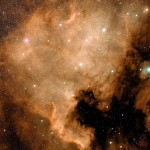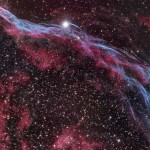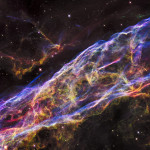Cosmic Gems
Searching for diamonds in the celestial haystack
An AFSIG article by Paul Trittenbach
Sailing for the new world
On August 3, 1492 Columbus set sail into the Western Atlantic and the unknown. He was seeking a short trade route to the East Indies, the land of spices, the gold standard of the time. At 2 AM on the morning of October 12 a lookout on the Pinta sighted land. Columbus had not reached the Americas however, in fact he never made landfall on North America. Instead, on that first voyage his ships made landfall on an island that he named San Salvador, believed to be one of the Cays in the Bahamas.
During his voyages of 1499-1500 Amerigo Vespucci made landfall in the South American continent, in an area of French Guyana then the mouth of the Amazon River. Vespucci was credited with discovering the American continent and both North and South America became named in his honor. Neither he nor Columbus had actually discovered the New World. Many others had come before them, including the Vikings. But no one can discount the enormous contributions that their explorations have added to history and how they have changed the world.
You and I stand on the North American continent, gazing up, awestruck by the cosmos overhead. We may not be explorers and discoverers but we are in our own right as we stargaze with our unaided eyes, binoculars, telescopes and through the various sources of media that help us to make discoveries of our own. And unlike the world’s great discoverers, we can do it in relative comfort, even in the frigid temperatures of winter.
On August 3, 2016 the moon will be waking up from its new moon slumber and showing us a thin sliver of itself. This seems to be an appropriate time to set sail for the cosmic shores of the North America Nebula (NGC 7000). The discovery of this faint emission nebula is attributed to William Herschel on October 24, 1786. But like the rest of history, it to may have first been landed upon—for all we know—by the Vikings.
The North America Nebula is a great expanse of stellar remnant that covers an area of 50 light years high by 40 light years across — covering an area of sky four times the diameter of the full moons! The North America Nebula lies about 3° off the port bow of Deneb, the brightest star in the constellation Cygnus. It is a faint patch of light, although some sources indicate that it is easily visible to the unaided eye in a very dark location. The nebula lives up to its namesake forming the outline of North America, Mexico and Central America. It is closely associated with a second patch of nebulosity — the Pelican Nebula (IC 5070). The two are separated by a dark lane of dust. Both are located 1800 light years distant and considered to be part of the same supernova remnant.

A star at least 10 times the mass of our sun reaches the end of its lifecycle and grows into a super red giant. In matter of a few seconds it expends the full amount of hydrogen of our sun — 10 billion years worth! The remaining matter loses its tug-of-war with gravity and collapses inward, producing heavier elements along the way. Finally, a devastating explosion blows the matter into interstellar space at 20,000,000 miles per second, leaving a sphere of oxygen and carbon the size of our earth — a white dwarf. A supernova is born.
The matter from this conflagration becomes an enormous interstellar molecular cloud, covering a volume of space that spans light years. It consists of complex chemical elements and compounds — including the gold in your jewelry and the organic compounds of your body. But nature is a great recycling machine and this material will not go to waste. Supersonic shockwaves, gravity and pressure will fabricate new stars and possibly planets and life itself. These cosmic stellar remains are a nebula.
NGC 7000 glows red in images, due to the ionized hydrogen that composes the cloud. The white dwarf embedded somewhere within the nebula emits ultraviolet light — an energy source so powerful that it can eject electrons from the hydrogen atoms and recombine them with protons in other atoms to emit light in the Hydrogen-alpha wavelength. An H-alpha or UHC filter should help you to see the nebula in greater detail.
Edwin Hubble originally suggested that the power source for NGC 7000’s cloud was Alpha Cygni —Deneb. Spectral analysis, however, dethroned Deneb. Other astronomers inferred that the star HD 199579 was the culprit. However, some debate exists around that star possessing the right spectral emissions to excite the hydrogen cloud.
The nebula is also a star producing region whose residents include two open star clusters: Collinder 428 and NGC 6997. NGC 6997 is the most obvious of the two star clusters and is located along the East Coast of North America. Collinder 428 resides in the location of the state of Washington. Along the western edge of Mexico and Central America is a bright wall, a star forming region known as the Cygnus Wall. This region is both lit and simultaneously eroded by young stars that are partially concealed by the dark dust lanes they have created. The Cygnus Wall spans a distance of 15 light years!
The associated Pelican Nebula, IC 5070, is an amalgamation of three structures (IC 5067, IC 5068 and IC 5070) collectively classified as IC 5070. This too is a churning molecular cloud of gas and dust, as evidenced in Hubble images, constructing new stars within. Because it is part of the same structure as NGC 7000 it glows red in images too. The two structures — NGC 7000 and IC 5070 — are separated by a dark dust lane, perhaps our analog of the Atlantic Ocean.
Once you have sailed the coastline of the North America Nebula and explored its interior, hoist your mainsail to shove off for the right wing tip of Cygnus. 4° south of Epsilon Cygni we find ourselves adrift in the Sargasso Sea of the Veil Nebula. Early mariners were petrified at the thought of becoming entombed in this expanse of seaweed desert in the Atlantic but we will be pleased to be lost here for some time. This large, filamentous patch of nebulosity is a part of a larger structure known collectively as the Cygnus Loop. The Veil Nebula, Caldwell 34, is a complex of multiple structures — including NGC 6960, Caldwell 33 (the Eastern Veil), NGC 6992, NGC 6995, NGC 6974, NGC 6979 and IC 1340.
The Veil Nebula is the remnant of a supermassive star that exploded about 8000 years ago. It’s name is derived from the filamentous structures that compose it. It is located approximately 2100 light years away and spans an area of sky of 110 light years. Because the nebula is spread over a very large area it appears very dim, regardless of the fact that it has a relative magnitude of 7. its filamentous appearance is attributed to shockwaves that are so thin that the shell is only visible when viewed edge-on.
High velocity shockwaves from the ancient explosion are plowing into a wall of cool, dense interstellar gas, causing it to omit the light of the nebula. At one time the star that created this nebula was more than 20 times the mass of our sun! The Veil Nebula glows from doubly ionized oxygen. It can be best viewed using an 0 III filter.

Hubble Space Telescope (HST) close-up images of the Veil Nebula reveals a bubble of gas that was blasted into interstellar space when its parent star detonated eight millennia ago. In the multi-spectral images it looks organic in appearance; an enormous transparent worm revealing its inner anatomical structures. Perhaps I am waxing romantic but it seems appropriate, with nebulas possessing organic compounds, to imagine it as more than a construct of pure physics. Images like this reveal so much more of the structure of these cosmic gems, enlightening us of the complexity and elegance of the cosmos.
To our eyes the gossamer structure of the Veil Nebula, matted against the jet black sky of interstellar space, is beautiful. It’s hard for us to imagine it as evidence of an immense nuclear bomb that detonated in our celestial neighborhood and was witnessed by ancient people. Perhaps in the cuneiform of the Sumerians or the oral stories of ancient American Indians there may be an eyewitness account of the event. Maybe one day we will uncover an edition of the Mesopotamian Daily Herald and read of one of the biggest news events of that time.
Having navigated the Veil Nebula we now set a compass heading 2.5° northeast of the double star Albiero and to the shores of Sharpless 2-91.To see this supernova remnant you will need a large aperture telescope.Use an OIII filter to view Sharpless 2 – 91. Sh 2 – 91 is a composite of tendril structures: Sh 2-91,Sh 2 – 94 and Sh 2 – 96. It is the shell of a star that exploded 20,000 years ago. This shell is 70 parsecs across and 2500 light years distant.

But Ahoy there, matey, we’re not through yet! After navigating the waters of Sh 2-91steer a compass heading 180° aft of Albiero and straight-on-through to the left wing of the Swan. The Swan swims along an enormous tear in the fabric of the Milky Way: the Great Rift. This is a lane of dark nebulosity that runs through the entire ribbon of the center of our galaxy. One point off our starboard bow we sight an orbicular dark cloud between Sadir and Deneb. This is a portion of the Great Rift known as the Northern Coalsack.
The Coalsack — that is to true Coalsack — is located in the southern constellation of Crux, 600 light years away from Earth. Whenever ancient mariners ventured into the southern seas and spied the Coalsack they shuddered in fear, for they believed it possessed properties of the occult. It is easy to understand how they must have felt; for it appears as a bottomless cavern amongst the stars. Our myths and religion are a bastion of hope pitted against our greatest fear of darkness and the unknown. Both the northern and southern coalsacks are icons of the primal impulses that can drive us mad with fear.
The Northern Coalsack spans an area of sky in northeastern Cygnus of 6° by 5°. It is the beginning of a long expanse of dark dust and gas that obscures and even conceals the stars behind it. This Great Rift slithers its way from Sagittarius to Cygnus. It gives the Milky Way its variegated appearance. Herein lies the irony of observing the Northern Coalsack: viewing it is like staring into the eye of some demonic spirit while simultaneously you are awestruck by a transcendent beauty. This dismal sea is flanked by two luminous bands of the Milky Way that make this piece of celestial eye candy worth relishing.
We may not have the navigational, morale and logistical concerns of Columbus and Vespucci. With a good star chart or a Go-To telescope we will not have weeks of endless cosmic ocean to cross to reach our destination. Secured in our holds will be our telescope, accessories and the all-important Oreo cookies. We may have to endure a long night away from our families but that’s the sacrifice of exploration. After all, it wasn’t easy for the ancient seafarers either. Bon voyage!

